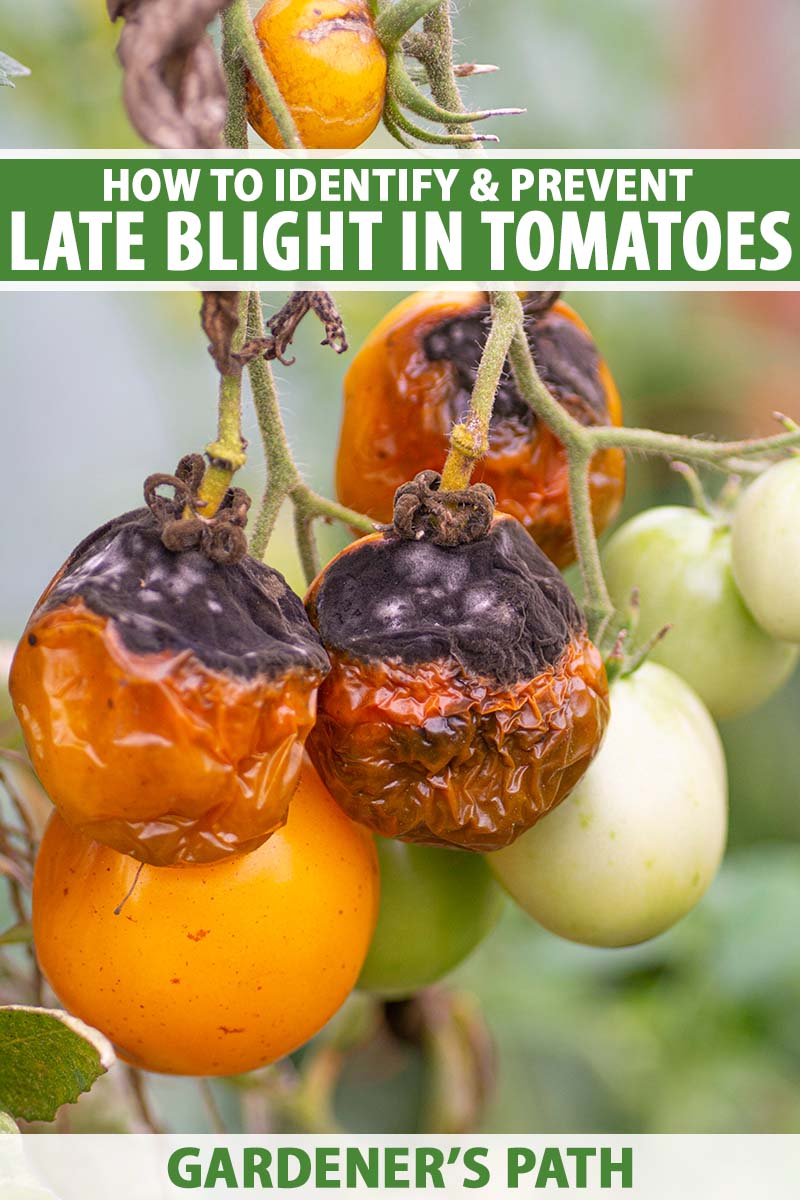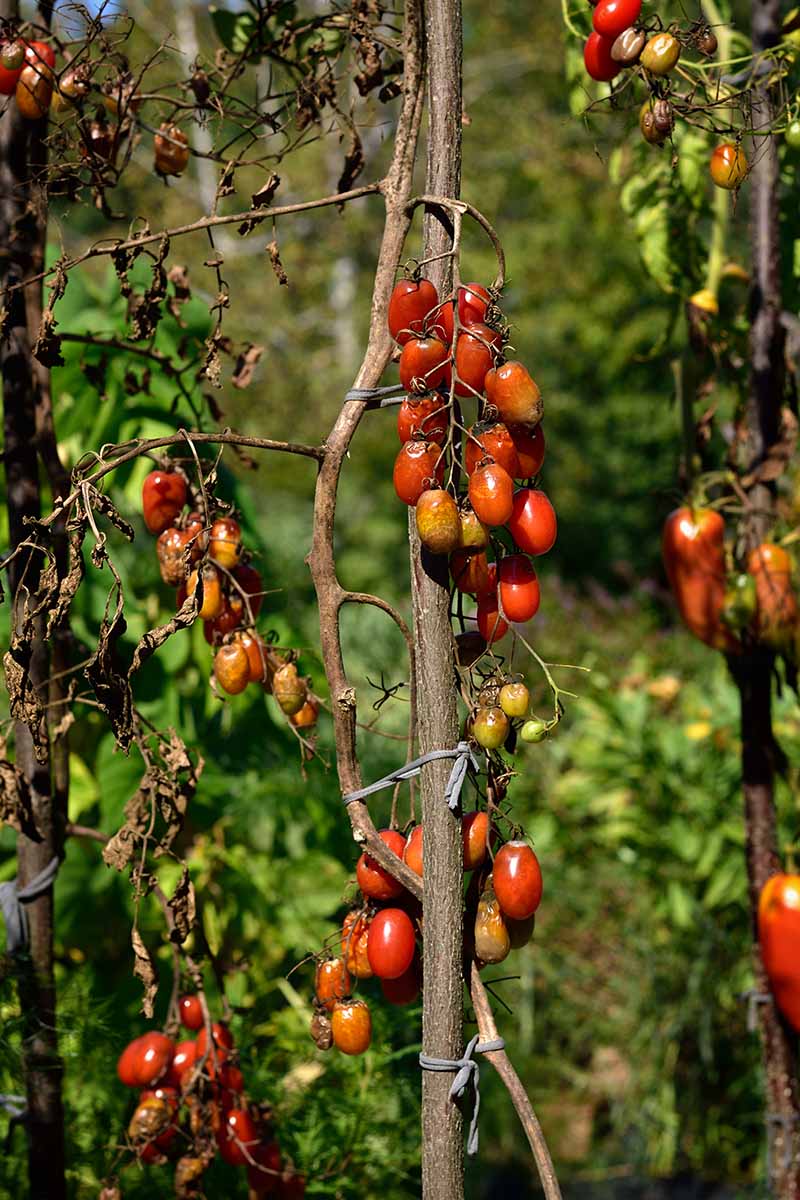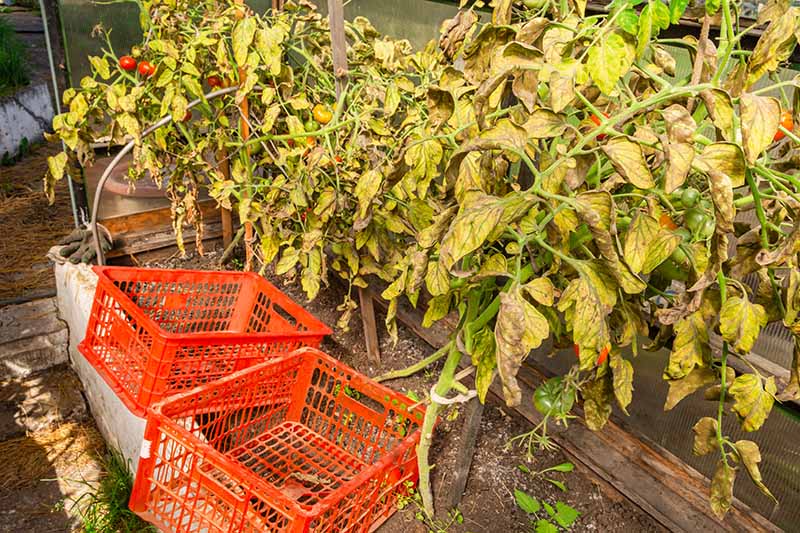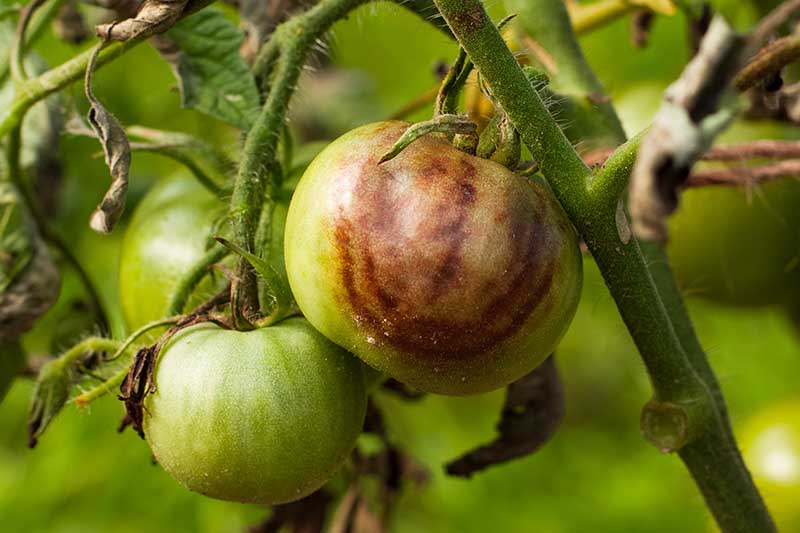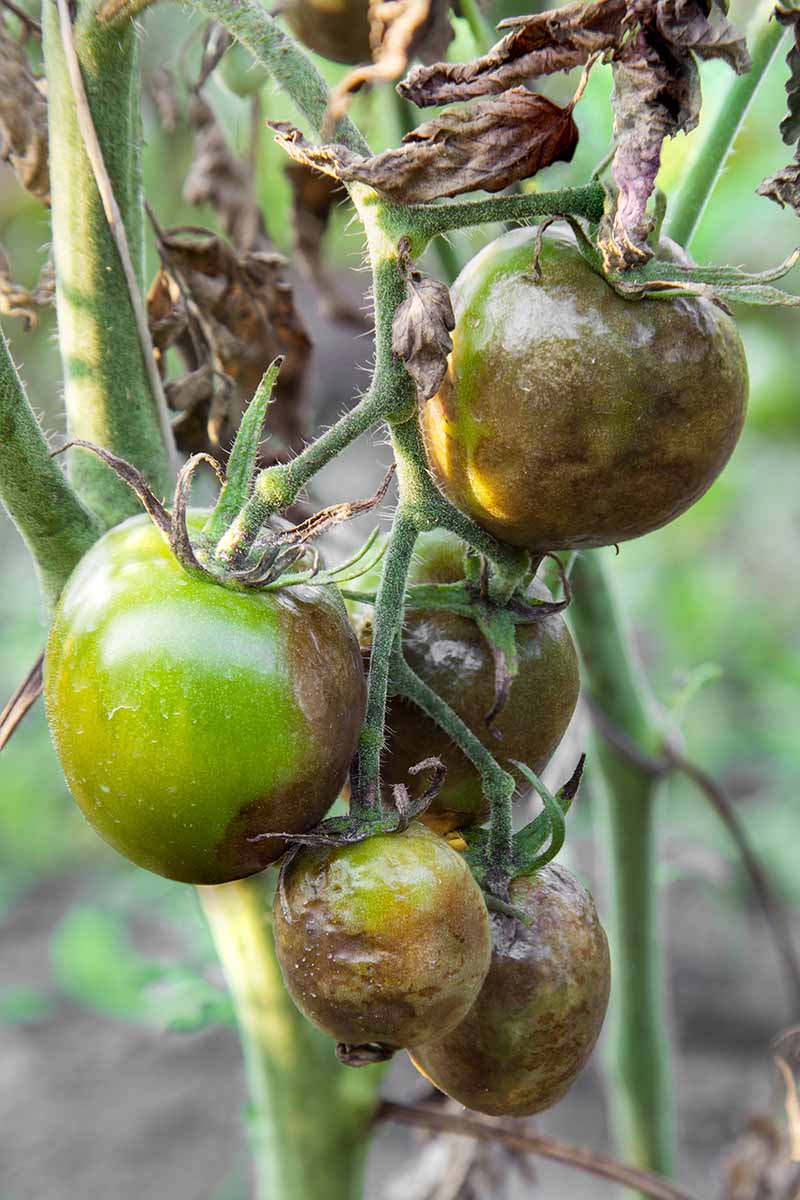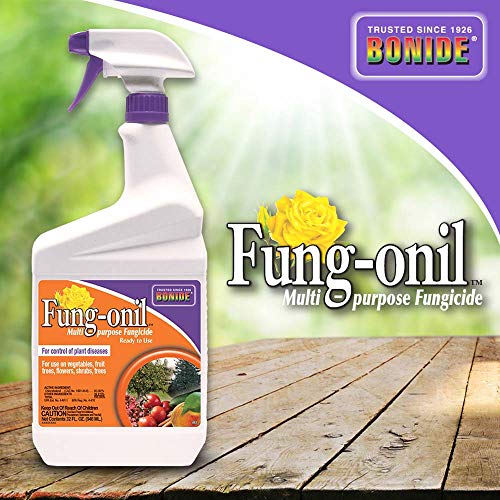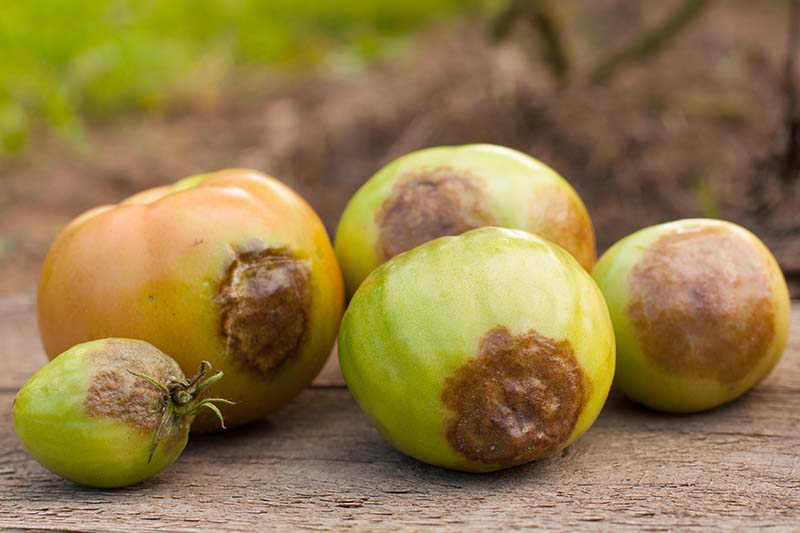You may not realize it, but you are probably already familiar with the organism that causes late blight. Phytophthora infestans was the cause of the infamous Irish potato famine of the 1840s. For over 200 years, this organism was thought to be a fungus, but it has since been reclassified. It is now referred to as an oomycete – also known as a water mold – thanks to its ability to thrive in wet conditions. Late blight is terminal, and identifying the problem early is critical to containing an epidemic. We link to vendors to help you find relevant products. If you buy from one of our links, we may earn a commission. In this article, I’ll show you how to diagnose a late blight infection, and how to limit the spread of the organism that causes it. I’ll also go over some methods to prevent an infection in the first place.
Why Late Blight Is Such a Serious Threat
There are many different strains of this pathogen. Some can infect both tomatoes and potatoes, but others are specialized for one host or the other. This disease can easily be introduced into gardens via infected tomato or potato plants. Once the plants have become infected, the organism can produce millions of spores in the right conditions. Wet, humid conditions caused by rainfall, dew, fog, or sprinkler irrigation are conducive to the spread of this pathogen. These spores can travel for miles in the air, and under ideal conditions, they can infect plants on a broad scale. The receptacles that hold the spores (sporangia) can survive for up to an hour in dry, sunny conditions – and much longer in wet ones. To give you an idea of the scale that we’re talking about, a single lesion can produce as many as 100,000 to 300,000 sporangia per day. And each individual sporangium can start a new infection on another plant. This type of water mold readily infects and may quickly kill plants. In fact, the scientific name Phytophthora translates to “plant destroyer.” The destructive ability of this pathogen makes it important for gardeners to be able to identify it and take swift action. It’s not just your crop that’s at stake, after all. The spores can spread rapidly to nearby gardens and even into commercial fields. In cool, wet weather, this disease can cause entire fields of tomatoes to turn brown and wilt as though they have been hit by frost.
Conditions That Favor Late Blight
Again, there is a reason that this type of pathogen is called a water mold. The organism requires humidity above 90 percent to cause infection, and moderate temperatures in the range of 60 to 68°F. If spores are present in these conditions, they can infect a plant in about 10 hours. Infection spreads rapidly, and plants can succumb quickly, in a matter of days. The spores can spread long distances on the wind, particularly in cloudy conditions. Though infection may occur more slowly, if nights are moderately warm, and conditions are extremely wet during the day but hot, the disease can still develop in temperatures as high as 95°F. Hot, dry conditions help to halt disease spread.
How to Identify Late Blight on Tomato Plants
This disease tends to occur later in the season than the similarly named early blight, typically after plants have bloomed, and when weather conditions are favorable. The first inkling that your tomato plants are infected will be evidenced by small, water-soaked lesions on the leaves. These will rapidly grow into large, irregular purple-brown blotches that may appear oily, with a green-gray edge. Look at the underside of the leaves with a hand lens. Under ideal conditions, the pathogen creates rings of grayish-white fungal threads, and structures that produce spores develop around the blotches. Whole leaves will turn brown and die, and the infection will quickly spread to the petioles and young stems. At this stage, stems can continue to spread spores for longer periods than what may occur if only the leaves are infected. If conditions are no longer favorable for further spread of the disease, lesions will have a brown, dead center surrounded by tissue that has collapsed, and can look grayish-green, yellowed, or water-soaked. The fruit may also be infected, and it usually shows symptoms on the shoulders first. This happens because the spores land on the fruit from above. The fruit will turn brown with greasy-looking spots but remains firm, unless infected by other organisms such as soft rot bacteria as well, which can penetrate damaged plant tissue. These brown patches can grow in size as the infection progresses, and turn leathery. Both green immature fruit and fruit that has ripened on the vine may be infected. Though unaffected parts of large fruit may still be technically edible, eating them is not recommended. Any infected portions or severely damaged fruit should be discarded. Other pathogens may be present, giving the fruit a bitter taste and causing it to continue to rot off the vine.
Monitor for Disease and Scout Your Garden
Experts strongly suggest that you scout your garden at least twice a week to look for symptoms of this disease. You should check more frequently during periods of wet weather. Late blight may infect some parts of gardens while others are spared. Start your search efforts in wet areas, including:
Low spots in your gardenDensely planted cropsPlanting areas next to woods or hedgerows
If you identify late blight, notify your county extension agent. Instances of this disease are monitored in local regions, and alerts may be available to growers when favorable conditions are in the forecast. USABlight, an online portal created at North Carolina State University, allows registered users to check for reports of infection in their local area, and you can report local disease occurrences or find information to submit samples for testing there as well.
How to Manage a Late Blight Infection
In an ideal world, your best option would be to grow tomatoes that are resistant to late blight. However, the oomycete keeps evolving and overcoming these traits in various hybrid varieties bred for resistance. Saved seeds from heirlooms should be safe to use, if they have been thoroughly dried. Note that seeds saved from hybrid varieties will not grow true to the parent plant. ‘Mountain Magic’ One has come on the market recently, and seeds for the cherry tomato cultivar ‘Mountain Magic’ are available from Burpee. This cultivar is also resistant to early blight. Unfortunately, this resistance can break down if conditions are highly favorable for infection. Only purchase plants from high-quality purveyors, preferably those who guarantee their plants to be free of disease. And be sure to inspect all plants for signs of disease before you place them in your garden. Besides planting resistant varieties, you may consider using fungicides to treat minor infections, depending on the progression of the disease and the local weather conditions. I’ll cover how to determine whether this is a viable option a little later in the article. But remember that this disease spreads rapidly under suitable conditions, and there is no cure. If you find evidence of late blight that is already severe, remove and destroy the diseased plants immediately. Dig them up in their entirety, till them under, or cut them off at the soil line and immediately bag them, so the spores will not spread. Ideally, you should destroy the plants on a dry, sunny day, so the spores will die quickly. But if the weather will remain wet for a while, it is better to destroy the plants immediately than to wait for a dry day. As described above, potatoes are also highly vulnerable to late blight. The organism may attack other solanaceous plants as well, including hairy nightshade (Solanum physalifolium), and petunias grown in greenhouses. Infected weeds may contribute to further spread. Purge hairy nightshade weeds from your garden and surrounding areas, and keep a close eye on your petunias for signs of infection if they’re growing nearby. Be sure to rotate nightshades with other crops from season to season when growing them in your garden, and check for spread to other vulnerable plants if they are growing in close proximity. Above all, prevention is key.
Prevention
There are several steps you can take to prevent late blight from taking hold in your garden. These include:
Removing any volunteer tomato and potato plants, and any wild nightshades, from the garden.Check starts before you plant them, to make sure they are free of disease symptoms.Avoid overhead sprinkler irrigation, and only water at the base of plants.
Removing weeds and volunteer seedlings is particularly important, since the pathogen can overwinter on tomato seeds as well as potato tubers, and produce infected seedlings the next season. Proper watering is a precautionary measure that can be taken to prevent all sorts of fungal diseases. Adequate airflow is also important, to reduce humidity and give your plants a chance to dry off after periods of rain. Be sure to provide proper spacing between plants, as recommended for the cultivars you have selected. Some gardeners like to remove the lower leaves from their tomato plants, effectively preventing any foliage from touching the surface of the soil. This can also help to prevent fungal disease, further supporting proper airflow and allowing wet foliage to dry more readily.
Fungicides
Fungicides may be used to alleviate early symptoms, but there is no cure for this disease. Check with your county extension agent to find out which fungicides are most effective against the late blight strains in your area. If you go this route, plan to use fungicides preventively when rain is in the forecast, or if you are using overhead irrigation. If a mild outbreak occurs, it is important to reapply fungicides at regular intervals for maximum effectiveness. It is important to rotate your use of fungicides or apply them in combination as recommended by a local extension agent to avoid fungicide resistance that will lead these products to be ineffective. Bonide Fung-onil Concentrate Note that this chemical has been banned in some areas, and proper precautions should always be taken to protect yourself and the local environment when applying chemicals in the garden.
Why Water Mold/Fungal Sex Matters
Maybe you don’t tend to think about the sex lives of fungi and water molds very often. But there are actually some really practical reasons to care about this phase of their life cycle. Microbes that reproduce sexually are much more likely to produce new mutations than those that reproduce asexually. And this matters, because this is how new races of fungi quickly arise that are more aggressive, and resistant to certain fungicides. Though asexual reproduction is more typical, sexual reproduction of these organisms does sometimes occur. It was once the case that late blight strains were only known to mate sexually in Mexico – not because it’s a nice vacation spot, but because this was the original source of the pathogen. Many of the newer mutants have been traced back to this part of the world. This has had severe implications for the control of late blight in the US among farmers and home gardeners as well, since resistance to a number of fungicides that were once highly effective developed in the 1980s, rendering them useless. Now, the strains capable of mating exist in the US as well, which may hasten the development of new strains of this lethal pathogen. Fortunately, there are resistant tomato varieties on the market, although you will still need to take precautions against late blight if you choose a resistant cultivar. Check your tomato plants for this disease at least twice a week, and take action immediately if it looks like your plants are infected. Enact good gardening practices like proper spacing, pruning for airflow, and thoughtful watering. Have you encountered late blight in your garden? Let us know in the comments, so we can learn from your experience! And for more articles on diseases and physiological disorders in tomato crops have a look at these guides next:
How To Identify, Prevent, and Treat Common Tomato DiseasesBlossom-End Rot: What to Do if Your Tomatoes Rot on the BottomTomato Big Bud Disease: Symptoms and Prevention Options
